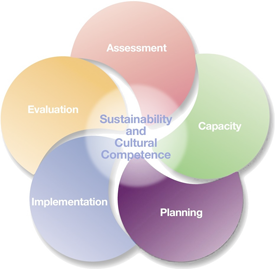Planning is pivotal to prevention success. Planning will increase the effectiveness of prevention efforts—by focusing energy, ensuring that staff and other stakeholders are working toward the same goals, and providing the means for assessing and adjusting programmatic direction, as needed. If done carefully, planning will also make future evaluation tasks much easier. Prevention practitioners at the state and jurisdiction levels engage in these planning activities:
- Establish criteria for prioritizing risk and protective factors associated with the identified priority problems, focusing on their importance and changeability.
- Develop a state-, tribe-, or jurisdiction-level logic model that links the consumption patterns and consequences of the priority problems, associated risk and protective factors, evidence-based strategies, and anticipated prevention outcomes.
- Develop a comprehensive and data-driven plan that includes a logic model, strategies for addressing resource and readiness gaps, anticipated evaluation activities, and how cultural competence will be addressed.
- Establish an Evidence-Based Workgroup responsible for determining what is evidence-based, soliciting proposals for community-level strategies, and reviewing and selecting those strategies.
Planning at the community and tribal levels addresses similar priority problems and associated risk and protective factors, but prevention practitioners focus on specific interventions and their intended consequences.
Good planning is also crucial to sustainability. It ensures the involvement and commitment of stakeholders beyond the initial funding period, establishes the organization structure necessary to maintain program activities over time, and greatly increases the likelihood that expected outcomes will be achieved. Whether planning happens within a formal coalition or among a more informal group of partners, decisions must reflect the ideas and input of diverse groups and individuals.
Many grantees have developed materials related to and/or describing their assessment processes. Links to these materials are contained on their respective state, tribe, or jurisdiction pages.
Selected SAMHSA's CAPT Services
- TA on developing SPF logic model, State plan, or Requests for Proposals from local grantees
- TA on creating guidance document to guide local-level implementation
- TA on selecting evidence-based and culturally-appropriate strategies
- Coaching for TA providers responsible for providing T/TA to SPF recipients



